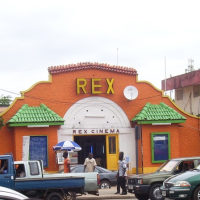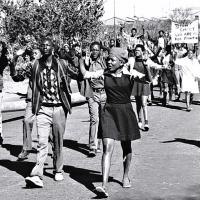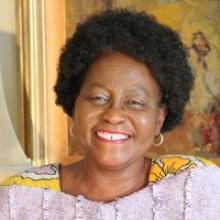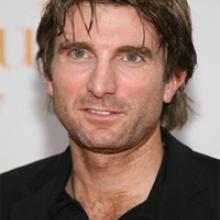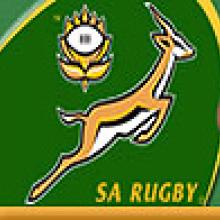One of the organisers of the 1956 Women's March, Lilian Ngoyi
Cape Town City Hall, Darling Street
The mayor of Cape Town, Thomas Ball, laid the cornerstone of the City Hall on 29 August 1900, but the Hall was only opened in 1905. It was designed by architects Reid and Green from Johannesburg and was built in Italian Renaissance style, one of the last major Victorian buildings to be erected in Cape Town.
Cape Town City Hall is one of our oldest and most central public spaces and home to the Cape Philharmonic Orchestra. Following a lengthy makeover, the: "heritage venue is available for a wide range of cultural and social events.
10 February 2022
Statement by Cape Town Mayor, Geordin Hill-Lewis: "As a former Member of Parliament and now Mayor of Cape Town, today marks a bittersweet moment. I was deeply saddened to witness our majestic national parliamentary buildings, situated right at the heart of Cape Town, gutted by flames earlier this year. However, I am proud that we were able to offer Parliament the use of one of the jewels in Cape Town’s crown — our newly-restored City Hall — to ensure that this year’s State of the Nation (SONA) can still go ahead. City Hall will also be used as the venue for the post-SONA debates, safeguarding the stability of an important institution in our democracy.
The design and History of Cape Town’s City Hall is a micro-example of the City’s complex and diverse Cultural Heritage. Built at the dawn of the twentieth Century, City Hall put Cape Town on equal footing with other Capital Cities across the World. It is one of the last Victorian Buildings to have been built in South Africa.
City Hall’s various components were sourced from all over the World. The honey-coloured limestone from which it was built was imported from Bath, England. The Building’s Tower houses; a clock and a number of bells, modelled on London’s Big Ben. The clock’s faces were modelled from iron filled with opal, most likely mined in Australia.
For nearly 70 Years, City Hall served a dual purpose. In its administrative wing, it served as the headquarters of the administration of Cape Town and the seat of its mayoralty. Its other portion was the Grand Hall, which has been used, until today, as a venue for music and the arts.
For many years, the Grand Hall was the only civic venue of significant capacity in the City, and was the performance venue of the famous Malay Choir and the Cape Philharmonic Orchestra (and its predecessors), as well as a venue for boxing competitions, musical competitions, civic banquets, and other government functions. The Grand Hall’s most impressive feature is a massive, 3 165-pipe organ, which is World-renowned for the quality of its workmanship and the beauty of its sound. The bass notes have been said to “reverberate through the body of the listener” and the higher notes to carry a pleasant tone that rivals the world’s best instruments.
In 1947, Princess Elizabeth (now Queen Elizabeth II) celebrated her 21st birthday at City Hall. City Hall has also been an important site in South Africa’s transition to democracy.
On February 11, 1990 mere hours after his release from prison, Nelson Mandela made his first public speech from the City Hall’s Main Balcony.( President Mandela’s release and of speech, delivered to 10 000 people who had gathered on the Grand Parade.)
Madiba’s speech began with immortal words, which still hold relevance for us today: “Comrades and fellow South Africans, I greet you all in the name of peace, democracy and freedom. I stand here before you not as a prophet, but as a humble servant of you, the people." The iconic event is memorialised by a life-sized statue of Madiba on the Balcony, in the exact position from which he delivered his address.
An extensive refurbishment project on City Hall has been undertaken by the City of Cape Town since 2017, ensuring that the building will remain a beautiful and useful building that all Capetonians can be proud of. The refurbishment included (from 2017 to 2018) an extensive revamp of the auditorium space in which SONA will be held, during which the seating was replaced; the floor, moldings and ceiling were restored; the organ was repaired; and new ventilation and sound systems were installed.
To mark the auditorium’s closure for refurbishment in 2017, the City hosted a free concert in the hall with a diverse range of musical acts, attended by hundreds of Capetonians. The auditorium was reopened to the public in 2018 with a multi-cultural event where visual art was on display, celebrating the diverse heritage in Cape Town and reaffirming the city’s values of inclusivity and diversity.
Tonight’s SONA is another milestone in this building’s important cultural history, and an important moment for Cape Town. In the spirit of the unity that City Hall represents, I am pleased that our offer of the building as a venue for Parliament was accepted by the Speaker and can be used by our President to communicate this year’s SONA to the public.
We hope to build on this collaborative spirit in the future, and wish Parliament and the President every success for SONA and the debates thereafter.:"
Geolocation
-33° 55' 31.15", 18° 25' 16.3088"
References
https://www.capetown.gov.za/Family%20and%20home/See-all-city-facilities/our-signature-venues/cape-town-city-hall
2022 - President Ramaphosa, State of the Nation Address, 10 February 2022
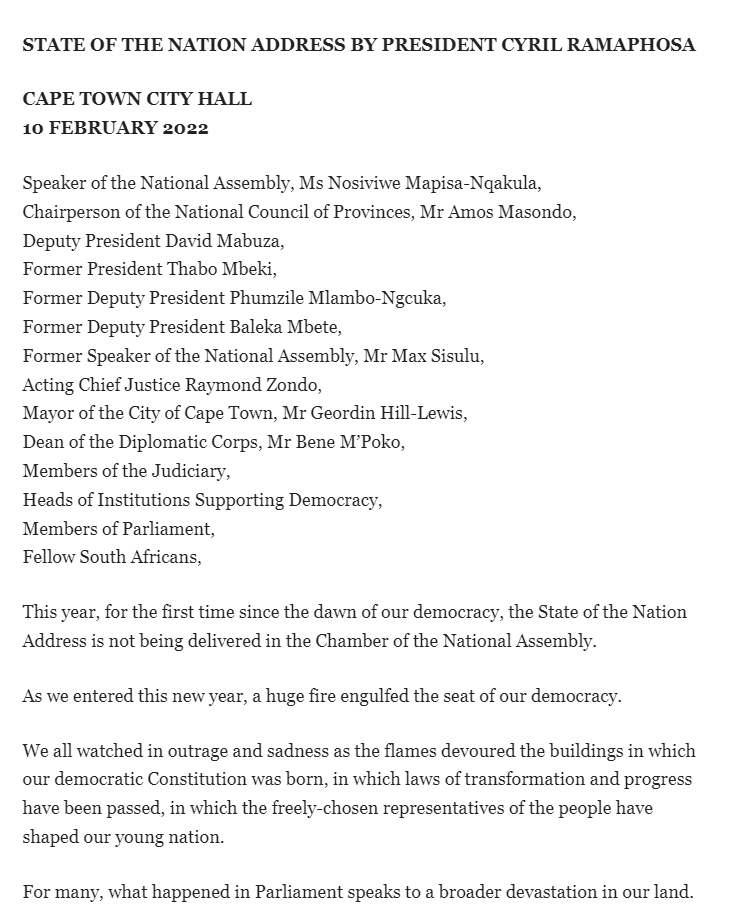
STATE OF THE NATION ADDRESS BY PRESIDENT CYRIL RAMAPHOSA
CAPE TOWN CITY HALL
10 FEBRUARY 2022
Language
Pietermaritzburg, Umgungundlovu District Municipality
Pietermaritzburg is the Capital and second-largest City in the Province of KwaZulu-Natal, South Africa. It was founded in 1838 and named after two leaders of the Voortrekkers Pieter Retief and Gert Maritz, who had arrived here in 1837. The Village was later taken over and made into a British military garrison as a defence in case of attacks. Many German and British immigrants settled here over the Years as the Town flourished, quaint Victorian and Edwardian Buildings and features remain today. Theses strong Victorian roots are evident in the well preserved architectural style of the buildings and general ambiance. It is now a City and the Administrative Capital of the KwaZulu-Natal Province. It is currently governed by the; Msunduzi Local Municipality. Its Zulu name: 'uMgungundlovu', is the name used for the District Municipality. Pietermaritzburg is popularly called: 'Maritzburg', in Afrikaans, English and Zulu alike, and often informally abbreviated to PMB. It is a Regionally important Industrial hub, producing: Aluminium, Timber and Dairy products, as well as the main Economic hub, of Umgungundlovu District Municipality. The public sector is a major employer in the City due to local, District and Provincial Governments located here.
The City has many Schools and Tertiary Education Institutions, including a campus of the University of KwaZulu-Natal.
It had a population of 228,549 in 1991; the current population now is estimated at over 600,000 residents. Pietermaritzburg is an emerging Metropolitan Area.
A City rich in History and heritage, Pietermaritzburg has a number of Museums, Galleries and Monuments of interest, Historical Buildings include: The City Hall, Macrorie House, Natal Museum, Old Colonial Building, Old Government House and Voortrekker House. The historic Railway Station became famous when Mahatma Ghandi was evicted from a train here in 1893, an event that set him on his Political path!
The newest Museum here is; Comrades Marathon House, the headquarters for an epic yearly road race between Pietermaritzburg and Durban which takes place at the end of May. The direction of the run alternates each year, one year downhill and the next uphill; its a grueling 90km (56 miles) and one of the toughest races in the world. Another interesting sport event that occurs here every year is the; 'Dusi Canoe Marathon', on the Umsindusi River which takes place over a strenuous 3 day course.
Church Street, has been converted into a pedestrian walkway and mall, a pleasant place to shop, browse and relax, there is also an interesting African Arts and Crafts centre with contemporary and traditional hand made works on display including rugs, batiks, jewellery, sculpture and collectors items.
There are a number of Parks, Gardens and Reserves around this City including the lovely Pietermaritzburg Botanical Gardens and across from the City Hall, the Garden of Remembrance - for the fallen in two world wars and the Weeping Cross of Delville Wood.
Geolocation
-29° 37' 52.7794", 30° 12' 39.8216"
References
https://artsandculture.google.com/entity/pietermaritzburg/m01_vrh?hl=en
https://www.siyabona.com/kwazulu-natal-pietermaritzburg.html#:~:text=Pietermaritzburg%20was%20founded%20in%201838,defence%20in%20case%20of%20attacks.
Further Reading
https://umdm.gov.za/
https://za.geoview.info/umsindusi_river,133733093w
http://www.msunduzi.gov.za/site/home/index.html
https://www.sa-venues.com/things-to-do/kwazulunatal/macrorie-house-museum/
https://census2011.adrianfrith.com/place/566003
https://www.sahistory.org.za/dated-event/gert-maritz-41-voortrekker-leader-dies
Home Page Backup - latest
Featured topics
This day in history
Find out who was born, who died and other significant events from this day in history
History in Images
A young victim of the atrocities committed by Belgium in the Congo stands next to a missionary.
Image Source:
www.wikimedia.org
Riot police play a game of soccer with youths in Nyanga on 27 August 1976. Photo by John Paisley
Image Source:
www.lib.uct.ac.za
A certificate of slavery for an infant named Sophie, dated 1827 Cape of Good Hope.
Image Source:
www.theculturetrip.com
Riot police attempt to block the way of workers leaving a May Day meeting at Khotso House in Johannesburg in May 1985.
Image Source:
www.digitalcollections.lib.uct.ac.za



